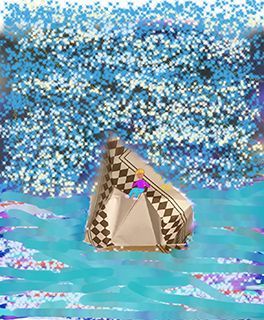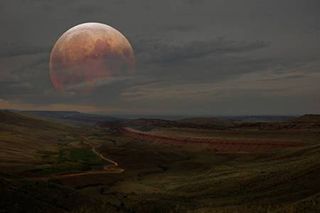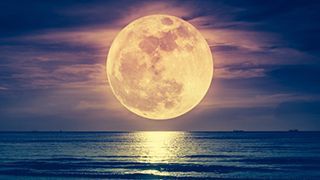Sailing on the Sea of Tranquility
Jane was the only one amongst you that took my advice and made a paper boat.
Once made, she set sail and as she is a world traveller of considerable reputation and experience she decided to venture a little further. So where do we find her sailing in her paper boat? On the Sea of Tranquility of course.

The Sea of Tranquility, or the Mare Tranquillitatis, is located on the moon. If we are going to talk about boring old facts I have to admit the Sea of Tranquility does not actually contain any water. But we are artists and so Jane is sailing in her little paper boat across the coloured misty atmosphere of dreamland.
As we are talking about Science and Art I had better give you the facts. The Sea of Tranquility is a flat, dark plain on the moon called a mare. It was the place that was chosen to be the landing site for the first lunar landing. Whereas much of the moon features craters formed by bombardment by objects during the moon's history, the mare regions are almost completely void of craters. The maria were formed by the oozing up and spreading of molten material from within the moon through cracks on the moon's surface. (Wikipedia)
As we head to the Count Down to the launch of the Rocket to the Moon it's a good time to reflect on the beautiful relationship Earth has with its moon.

And what would it be like if we didn't have our moon?
- A few consequences come immediately to mind:
- Neil Armstrong’s life would have been less exciting.
- Audrey Hepburn wouldn’t have sat on the stairs with a guitar and played “Moon
River” in the movie Breakfast at Tiffany’s. - And the myth of werewolves wouldn’t have existed – at least not in the form we know it today.
- Of course it would be darker at night. (sciencenordic.com)
But what major outcome would it have on the Earth in general?
Hanne Jakobsen from Science Nordic contacted Kaare Aksnes (Professor Emeritus at the Institute for Theoretical Astrophysics at the University of Oslo) for an answer.
In short we would have less difference between high and low tides, shorter days and a more extreme climate,” he says. (sciencenordic.com)
Why then, if the moon is so important, why doesn't it have a name? Of course, it is called The Moon, a label left over from the time long ago when it was believed that there was only one moon. But now we know better. In our Solar System there are nearly 350 moons. So it is time we gave our moon a name.
Some cultures do have a name for our moon. The ancient Greeks called it Selene; in Latin and Spanish, it is Luna and in Swahili, it is Mwezi.
But I'm starting a competition to give our moon a name that embraces all cultures and all the dreams that everyone has regardless of background: and all the emotions evoked when we gaze up into its beauty from Earth.

